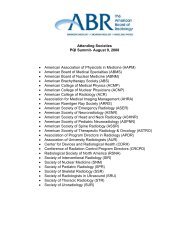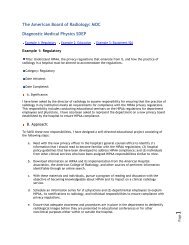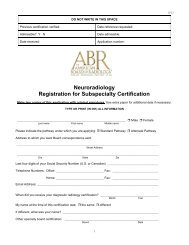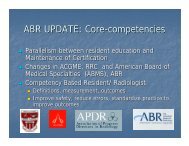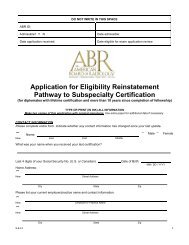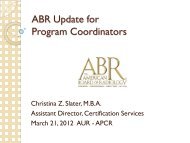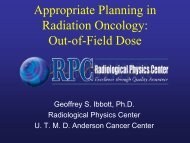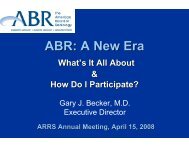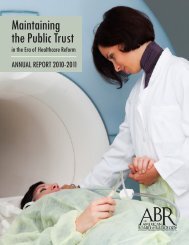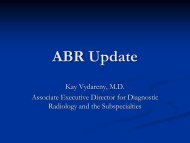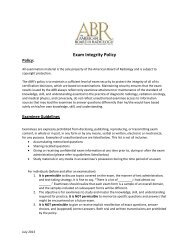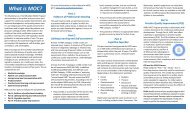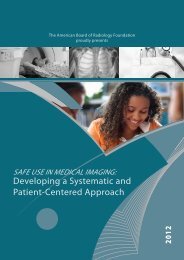Download the presentation - The American Board of Radiology
Download the presentation - The American Board of Radiology
Download the presentation - The American Board of Radiology
You also want an ePaper? Increase the reach of your titles
YUMPU automatically turns print PDFs into web optimized ePapers that Google loves.
DISCLOSURE<br />
Member, <strong>Board</strong> <strong>of</strong> Directors<br />
<strong>The</strong> <strong>American</strong> <strong>Board</strong> <strong>of</strong> Medical Specialties
Aim for MOC (all boards):
Booking Airline Travel
Factors in Flight Selection<br />
• Tucson origin: limited carriers, flights<br />
• Carrier <strong>of</strong> choice: Does AA fly <strong>the</strong>re<br />
• Flight choice: meeting schedule, $$$ price<br />
• Schedules + nonstops / connections<br />
• Return options, compounded travel<br />
• Frequent flyer miles<br />
• Equipment: not really<br />
• Pilot qualifications
Airline Transport Pilot License<br />
(ATPL) (FAA-qualified to fly<br />
commercial jetliners): Highest<br />
=<br />
Have embraced:<br />
Primacy <strong>of</strong> passenger safety<br />
Standards<br />
Team/crew training, responsibility<br />
Checklists<br />
Mandatory training, simulation<br />
Federal oversight<br />
Have relinquished:<br />
All o<strong>the</strong>r possible considerations<br />
Individuality <strong>of</strong> approach<br />
Autonomy<br />
Dependence on memory, experience<br />
Luck-<strong>of</strong>-<strong>the</strong>-draw experience<br />
Self-regulation<br />
<strong>Board</strong> Certification and<br />
Participation in MOC =
“<strong>The</strong>y have also made <strong>the</strong> improbable come<br />
true. High-volume, high-speed jet travel is<br />
<strong>the</strong> safest form <strong>of</strong> transportation in <strong>the</strong><br />
world.”
1999 INSTITUTE OF MEDICINE<br />
Report in Perspective<br />
If this were <strong>the</strong> safety record <strong>of</strong> <strong>the</strong> airline industry, I<br />
would not have flown here to give this talk!<br />
• Assume 71,000 deaths per year…<br />
• 195 deaths per day…<br />
• Equivalent to…<br />
44,000 to<br />
98,000<br />
deaths/year<br />
One 737 loaded<br />
with passengers<br />
crashing every<br />
day…<br />
…all<br />
year<br />
long
U.S. Airways Flight 1549<br />
January 15, 2009, Capt. Chesley B. Sullenberger,<br />
First Officer Jeffrey B. Skiles, and crew<br />
successfully landed an Airbus-320-214 on <strong>the</strong><br />
Hudson River after a bird (Canadian Geese)<br />
strike incapacitated both engines. This event<br />
fur<strong>the</strong>r streng<strong>the</strong>ned <strong>the</strong> public’s image <strong>of</strong><br />
commercial pilots and aviation.
• If board certification could guarantee<br />
patient safety and high quality care by<br />
physicians (“Good Housekeeping Seal <strong>of</strong><br />
Approval”), perhaps we would not have<br />
such a large array <strong>of</strong> stakeholders<br />
demanding a dominant voice in physician<br />
peformance measurement, public<br />
reporting, and payment reform.
Groups Weighing in on Physician<br />
Performance Measurement<br />
• National consumer groups (AARP, Consumer’s Union)<br />
• Business coalitions (Leapfrog, Pacific Business Group)<br />
• Unions (AFL-CIO, SEIU)<br />
• Insurers (BCBS, United Health, AHIP, o<strong>the</strong>rs)<br />
• Quality organizations (AQA, QASC, etc.)<br />
• Accrediting/certifying bodies (ABMS, NCQA, TJC, etc)<br />
• Private non-pr<strong>of</strong>its (IOM, NQF, IHI)<br />
• Government (CMS, AHRQ, CDC, NIH, o<strong>the</strong>r)<br />
• Healthcare pr<strong>of</strong>essionals (AMA, AHA, ANA, etc.)
• Specialty board certification: very brief history<br />
• Influence <strong>of</strong> <strong>the</strong> quality and safety movement<br />
• Emergence <strong>of</strong> MOC<br />
• Why and how <strong>the</strong> pr<strong>of</strong>ession and board<br />
certification must change and are changing<br />
• What’s new in MOC today, and why MOC<br />
makes sense for you
Flexner Report: Impact on Medical<br />
Education<br />
1908-1910<br />
• 155 U.S. medical schools, many<br />
proprietary<br />
• Standards: extremely low to none<br />
• Lab, clinical conditions abysmal<br />
• Testing <strong>of</strong> knowledge, skill lacking
Atlanta College <strong>of</strong> Physicians & Surgeons (1898, independent)<br />
Atlanta School <strong>of</strong> Medicine (1905, independent)<br />
Georgia Coll. <strong>of</strong> Eclectic Medicine & Surgery (1877, independent)<br />
“Its anatomy room, containing a single cadaver, is<br />
indescribably foul…<strong>The</strong> school is practically without clinical<br />
facilities. Its outfit in obstetrics is limited to a tattered<br />
manikin…Nothing more disgraceful calling itself a medical<br />
school can be found anywhere.” (visited February, 1909)<br />
Hospital Medical College (1908, independent; secessionists)<br />
Medical College <strong>of</strong> Georgia (1828)<br />
Lab: “…exceedingly foul dissecting room.” Clinic: City<br />
Hospital, (100 beds); dispensary, no records kept.
EMORY: Atlanta Medical College began<br />
accepting students 1859. In 1898, it<br />
merged with <strong>the</strong> Sou<strong>the</strong>rn Medical College<br />
to form <strong>the</strong> Atlanta College <strong>of</strong> Physicians<br />
and Surgeons. In 1913, ACPS merged with<br />
<strong>the</strong> Atlanta School <strong>of</strong> Medicine. In 1917,<br />
Emory University School <strong>of</strong> Medicine was<br />
admitted into <strong>the</strong> AAMC.
Standardization <strong>of</strong> Medical Education
• Physicians simply chose area <strong>of</strong> practice<br />
–General practice<br />
–Surgery<br />
–ENT<br />
–Ophthalmology<br />
–Etc.<br />
• Public subjected to unscrupulous<br />
characters, charlatans, danger<br />
• Hospitals: dreadful places where hopeless<br />
went to die
• 1908 – Dr. Derrick T. Vail, Sr.<br />
presidential address to <strong>the</strong><br />
<strong>American</strong> Academy <strong>of</strong><br />
Ophthalmology and<br />
Otolaryngology<br />
“… and if he sound competent, let<br />
him <strong>the</strong>n be permitted and<br />
licensed to practice<br />
ophthalmology.”<br />
Photograph: William L. Benedict, MD Collection, Museum <strong>of</strong> Vision and <strong>the</strong> <strong>American</strong> Academy <strong>of</strong> Ophthalmology
•Established to assure <strong>the</strong> public that <strong>the</strong><br />
physician has specific qualifications<br />
– <strong>American</strong> <strong>Board</strong> <strong>of</strong> Ophthalmology 1917<br />
– <strong>American</strong> <strong>Board</strong> <strong>of</strong> Otolaryngology 1924<br />
– <strong>American</strong> <strong>Board</strong> <strong>of</strong> Obstetrics 1930<br />
– <strong>American</strong> <strong>Board</strong> <strong>of</strong> Dermatology 1932<br />
•Advisory <strong>Board</strong> for Medical Specialties<br />
(forerunner <strong>of</strong> ABMS) established 1933<br />
–<strong>The</strong> 4 <strong>Board</strong>s<br />
–Associate Member organizations
<strong>The</strong> <strong>American</strong> <strong>Board</strong>s <strong>of</strong>:<br />
• Allergy and Immunology<br />
• Anes<strong>the</strong>siology<br />
• Colon and Rectal Surgery<br />
• Dermatology<br />
• Emergency Medicine<br />
• Family Medicine<br />
• Internal Medicine<br />
• Medical Genetics<br />
• Neurological Surgery<br />
• Nuclear Medicine<br />
• Obstetrics and Gynecology<br />
• Ophthalmology<br />
• Orthopaedic Surgery<br />
• Otolaryngology<br />
• Pathology<br />
• Pediatrics<br />
• Physical Medicine and<br />
Rehabilitation<br />
• Plastic Surgery<br />
• Preventive Medicine<br />
• Psychiatry and Neurology<br />
• <strong>Radiology</strong><br />
• Surgery<br />
• Thoracic Surgery<br />
• Urology<br />
38 primary, 118 subspecialty certificates, as <strong>of</strong> November 2012
•Established 1934<br />
•Today: 3 Primary Certificates (DR, RO, MP)<br />
1 more just approved: IR/DR<br />
•Subspecialties<br />
– Neuroradiology<br />
– Vascular & Interventional <strong>Radiology</strong><br />
– Pediatric <strong>Radiology</strong><br />
– Nuclear <strong>Radiology</strong><br />
– Hospice and Palliative Medicine<br />
•Maintenance <strong>of</strong> Certification: All disciplines
“… to serve patients, <strong>the</strong> public, and <strong>the</strong> medical<br />
pr<strong>of</strong>ession by certifying that its diplomates have<br />
acquired, demonstrated, and maintained a<br />
requisite standard <strong>of</strong> knowledge, skill,<br />
understanding, and performance essential to<br />
<strong>the</strong> safe and competent practice <strong>of</strong> Diagnostic<br />
<strong>Radiology</strong>, Radiation Oncology and Medical<br />
Physics.”
• Safe, high-quality patient care<br />
• Well-placed confidence <strong>of</strong> <strong>the</strong> public in <strong>the</strong><br />
skills, knowledge, and competence <strong>of</strong> ABR<br />
diplomates
BOARD 2000-2010 CUMULATIVE<br />
• Internal Med 76,791 241,225<br />
• Family Med 34,352 103,755<br />
• Pediatrics 30,168 99,283<br />
• Psych / Neuro 19,150 66,554<br />
• <strong>Radiology</strong> 14,568 57,094<br />
• Surgery 12,066 59,981
•System <strong>of</strong> pr<strong>of</strong>essional self-regulation<br />
•<strong>Board</strong>s/physicians fulfill social contract<br />
•Voluntary (whereas licensure is compulsory)<br />
•Linkage: certification and accredited training<br />
•Unlike UK and Canada: <strong>Board</strong>s are not<br />
membership organizations<br />
•Firewall between educ/training and assessment<br />
•Has withstood test <strong>of</strong> time; global gold standard
<strong>Board</strong> Certification=Gold Standard<br />
May 2008 Opinion Research Corp. Telephone Poll<br />
When asked:<br />
“Key factors when choosing a doctor…”<br />
95% bedside manner; communication skills<br />
91% board certification<br />
82% friend or family member recommendation<br />
78% doctor’s hospital affiliation<br />
75% doctor’s <strong>of</strong>fice location<br />
60% hospital or school where doctor trained
Public values maintenance <strong>of</strong><br />
board certification<br />
August 2003 Gallup Poll:<br />
When asked:<br />
“If you knew your doctor’s board certification<br />
had expired, would you change doctors”<br />
54% Very Likely<br />
27% Somewhat Likely<br />
9% Not Too Likely<br />
8% Not at All Likely<br />
81%<br />
5
David L. Nahrwold, M.D.<br />
ABMS Executive Committee<br />
Retreat<br />
January 1998<br />
“…<strong>the</strong> ABMS and its member boards have <strong>the</strong> obligation<br />
to assure <strong>the</strong> public that <strong>the</strong>ir doctors are competent and<br />
that this should be done through <strong>the</strong> certification and<br />
recertification process.”<br />
Birth <strong>of</strong> MOC
• Medical knowledge<br />
• Patient care [and procedural skill]<br />
• Interpersonal and communication skills<br />
• Pr<strong>of</strong>essionalism<br />
• Practice-based learning and improvement<br />
• Systems-based practice
• Pr<strong>of</strong>essional Standing<br />
• Lifelong Learning and Self-assessment<br />
• Cognitive Expertise<br />
• Practice Performance Improvement<br />
(ABR’s Practice Quality Improvement—PQI)
Quality and Safety Movement<br />
•Nothing <strong>of</strong> this importance or magnitude since Flexner<br />
•Models: quality manufacturing, systems engineering<br />
•Rationale: healthcare systems are complex;<br />
goals difficult to achieve (eg. safety)
INSTITUTE OF MEDICINE<br />
2001<br />
• Safe<br />
• Effective<br />
• Patient-centered<br />
• Timely<br />
• Efficient<br />
• Equitable
Quality Aim<br />
People get <strong>the</strong> care <strong>the</strong>y need<br />
People need <strong>the</strong> care <strong>the</strong>y get<br />
Provided safely<br />
Timely<br />
Patient-centered<br />
Delivered efficiently<br />
Delivered equitably<br />
Improvement<br />
Opportunities<br />
Problem to Address<br />
Underuse<br />
Overuse<br />
Error, harm<br />
Delays<br />
Unresponsive<br />
Waste<br />
Disparities<br />
IOM, Crossing <strong>the</strong> Quality Chasm (2001)
• Where <strong>the</strong> rubber meets <strong>the</strong> road<br />
• Part 4 <strong>of</strong> MOC: we demonstrate what we do,<br />
not just what we know; we strive to improve.<br />
• Pr<strong>of</strong>ession does its part in <strong>the</strong> quality and<br />
safety movement
Minimal shift<br />
in overall quality<br />
Goal:<br />
an overall<br />
quality<br />
shift<br />
Identify<br />
outliers
Adults received<br />
55% <strong>of</strong> care<br />
that is<br />
recommended<br />
Children<br />
received 46% <strong>of</strong><br />
<strong>the</strong> care that is<br />
recommended<br />
McGlynn EA, Asch SM, Adams J, et al. <strong>The</strong><br />
quality <strong>of</strong> health care delivered to adults in <strong>the</strong><br />
United States. NEJM 2003;348:2635-45.<br />
Mangione-Smith R, deCrist<strong>of</strong>aro AH, Setodji CM,<br />
et al. <strong>The</strong> quality <strong>of</strong> ambulatory care delivered to<br />
children in <strong>the</strong> United States. N Engl J Med<br />
2007;357(15):1515-23.
National Healthcare Expenditure by Source<br />
Lee PV, Berenson RA, Tooker J. NEJM 2009
In a predominantly publiclyfunded<br />
healthcare system…<br />
• Who (what entity) determines <strong>the</strong> minimum<br />
quality practice standard<br />
• Who determines whe<strong>the</strong>r a practitioner has<br />
met <strong>the</strong> standard<br />
• How is <strong>the</strong> value ($$cost/outcome) <strong>of</strong> a<br />
particular healthcare service determined
“I strongly urge <strong>the</strong> ABMS—with its Member<br />
<strong>Board</strong>s--to position itself as <strong>the</strong> agency for<br />
physician accountability in a governmentcontrolled<br />
or government-directed healthcare<br />
system. That is, assume <strong>the</strong> task <strong>of</strong> certifying to<br />
<strong>the</strong> government as well as to <strong>the</strong> public that its<br />
doctors are competent and that <strong>the</strong>y are<br />
accountable for <strong>the</strong>ir work.”<br />
David L. Nahrwold. Remarks on receiving <strong>the</strong> Derrick T. Vail Award, September 18, 2007
Fortunately, as 2012 ends:<br />
• ABMS & boards have been proactive<br />
• MOC has been included in ACA 2010<br />
• We are entering 3 rd year <strong>of</strong> MOC:PQRS<br />
• CMS will include board certification and MOC<br />
status on Physician Compare website<br />
• CMS has turned to specialty boards for help<br />
with measures and value modifiers<br />
• MOC as equivalent <strong>of</strong> PQRS under discussion
<strong>Board</strong>s perceive need to maintain<br />
autonomy, uniqueness<br />
MOC standards a work-in-progress;<br />
rules change<br />
Gradual transition to all time-limited<br />
certificate holders<br />
Perception <strong>of</strong> MOC as added burden,<br />
unfunded mandate<br />
Value <strong>of</strong> MOC<br />
Consumers’, purchasers’, payers’,<br />
credentialing bodies’ need to know<br />
MOC appears complex and<br />
heterogenous to external gps<br />
Credibility <strong>of</strong> boards with <strong>the</strong>ir<br />
diplomates<br />
Pace <strong>of</strong> full adoption <strong>of</strong> MOC<br />
MOC should fit seemlessly<br />
into daily workflow<br />
Demonstrate MOC outcomes,<br />
effectiveness<br />
Reporting all needed info in<br />
understandable terms; risk<br />
adjustment, attribution/team<br />
care; system <strong>of</strong> care
To simplify MOC participation rules, continue <strong>the</strong><br />
evolution to a more continuous process, and<br />
comply with <strong>the</strong> ABMS standard on public<br />
reporting <strong>of</strong> diplomate MOC status, ABR is doing<br />
<strong>the</strong> following:
• MOC reality: Continuous is best<br />
• All 6 competencies must become integral to<br />
ongoing practice<br />
• Keeping up on medical knowledge<br />
• Improving patient care and procedural skill<br />
• Practicing pr<strong>of</strong>essionalism<br />
• Effectively communicating and relating to o<strong>the</strong>rs<br />
• Practice-based learning and improvement<br />
• Systems-based practice
• Certificates issued in 2012 and after no<br />
longer have “valid through” dates – instead,<br />
ongoing validity <strong>of</strong> <strong>the</strong> certificate is<br />
contingent upon meeting MOC requirements<br />
• Annual look-back to determine MOC status.<br />
• Rolling 3-year look-back window<br />
• MOC requirements and fees unchanged
How does continuous certification work<br />
MOC Year Look-back date Element(s) Checked<br />
2012 3/15/2013 Licensure, Exam<br />
2013 3/15/2014 Licensure, Exam<br />
2014 3/15/2015 Licensure, Exam<br />
2015 3/15/2016 Licensure, CME, SA, Exam, and PQI<br />
2016 3/15/2017 Licensure, CME, SA, Exam, and PQI<br />
2017 3/15/2018 Licensure, CME, SA, Exam, and PQI<br />
2018 3/15/2019 Licensure, CME, SA, Exam, and PQI<br />
20XX 3/15/20XX Licensure, CME, SA, Exam, and PQI<br />
Element<br />
Licensure<br />
CME<br />
SAMs<br />
Exam<br />
PQI<br />
Compliance Requirement<br />
At least one valid state medical license<br />
At least 75 Category 1 CME in previous 3 years<br />
At least 1/3 <strong>of</strong> CME incorporates self-assessment<br />
Passed any ABR Certifying or MOC exam in previous 10 years<br />
Completed at least 1 PQI project in previous 3 years
Advantages <strong>of</strong> Continuous Certification<br />
• If > 2 time-limited certificates synchronized.<br />
• <strong>The</strong> number <strong>of</strong> CME and self-assessment<br />
credits counted per year is unlimited.<br />
• MOC exam may be taken any time, provided<br />
previous MOC exam was passed < 10 yrs ago<br />
• Built-in “catch-up” period <strong>of</strong> one year – still<br />
certified.<br />
• Aligns reporting more closely with CMS, TJC,<br />
credentialing and state licensing board rqmts.
Public Reporting <strong>of</strong> MOC Status<br />
• Beginning March 2013: ABR will begin to report to<br />
ABMS <strong>the</strong> MOC status (by certificate) <strong>of</strong> every<br />
diplomate. Public reporting, an important driver <strong>of</strong><br />
healthcare transformation, began for 7 <strong>of</strong> <strong>the</strong> boards<br />
as early as August 2011.<br />
• Info is to be displayed on ABMS website and ABR<br />
website:<br />
‒ Meeting <strong>the</strong> Requirements <strong>of</strong> MOC<br />
‒ Not Meeting <strong>the</strong> Requirements <strong>of</strong> MOC<br />
‒ Not Required to Participate in MOC (Lifetime Certificates)
About Public Reporting<br />
If not us <strong>the</strong>n who:
• Initially, apprehensive about enrolling, participating<br />
• Still asking about immediate benefits (to <strong>the</strong>m)<br />
• Concerns: exams, fees, requirements<br />
• Want no exams, but if <strong>the</strong>y must, exams should be:<br />
• Free<br />
• Taken from home<br />
• Tailored precisely to my practice<br />
• Automatically passed<br />
• Don’t understand Part IV<br />
• Myths and misconceptions
• Loss <strong>of</strong> lifetime certificate<br />
• Once you’re in MOC, you can’t get out<br />
• Your MOC exam results are shared with<br />
institution, credentialers, etc.<br />
• I won’t ever need MOC to practice – likely<br />
wrong because <strong>of</strong>: P4P, TJC, credentialers,<br />
public reporting <strong>of</strong> MOC status, MOL, etc.<br />
• Not a myth: Pressure mounting, as TLC<br />
diplomates are near to becoming <strong>the</strong> majority;<br />
whole group practices enrolling
• Right thing to do pr<strong>of</strong>essionally<br />
• Valued by patients and physician colleagues<br />
• Maintains a credential you worked hard to earn<br />
• Public reporting <strong>of</strong> “meeting MOC requirements”<br />
• Satisfies CME and self-assessment requirements<br />
• P4P: PQRS:MOC incentives from CMS<br />
• Qualifies you to bill (some health plans)<br />
• MOC aligning with credentialing, TJC, MOL, etc., and<br />
<strong>the</strong>reby decreasing burden on diplomates<br />
• Letter <strong>of</strong> MOC Enrollment available immediately<br />
• Additional certificate if “meeting <strong>the</strong> requirements” <strong>of</strong><br />
MOC at first look-back (continuous certification)
Making MOC painless for individuals<br />
and group practices…
Milton J. Guiberteau, MD, Chair, President-Elect<br />
James P. Borgstede, MD, President<br />
Thomas M. Anderson, MD<br />
Eric Brandser, MD<br />
Greg Galdino, MD<br />
Richard Gunderman, MD<br />
Ramsey K. Kilani, MD<br />
Amy B. Kirby, MD<br />
Christine A. Lamoureaux, MD<br />
Alex Margulis, MD<br />
Mark E. Mullins, MD
• Optional program<br />
• Group practice administrator has access to MOC<br />
data on PDB<br />
• Easy system for tracking MOC progress <strong>of</strong> individual<br />
diplomates in a group practice<br />
• Requires each diplomate to: 1) approve GPA<br />
access, 2) access own PDB >1 time/year & verify<br />
• Reporting function<br />
• Now in beta-testing<br />
• Live version for widespread use: early 2013
Group Practice Administrator
Diplomate Notification
• Group Definition<br />
- 2 or more radiologists, radiation oncologists, or<br />
medical physicists<br />
• Requirements<br />
- All members <strong>of</strong> group must participate, including<br />
Lifetime Certificate Holders<br />
- Annual fees must be paid in aggregate<br />
- Must use Group MOC Online Administrative Tool<br />
• Discount: 10% <strong>of</strong> <strong>the</strong> total fees due<br />
• Available January 2014
HEALTH CARE REFORM LEGISLATION<br />
MARCH 2010
• Since 2011: CMS recognizes MOC participation<br />
as marker <strong>of</strong> physician quality<br />
• ABR is CMS-qualified to attest to CMS on behalf<br />
<strong>of</strong> participating diplomates<br />
• For 2012, participant must:<br />
‒ Enroll in MOC, if not already enrolled<br />
‒ Maintain valid & unrestricted medical license(s)<br />
‒ 30 CME & 3 Self Assessment (SAM) credits<br />
‒ Attest to completion <strong>of</strong> >1 PQI project<br />
‒ Attest to completion <strong>of</strong> a patient experience-<strong>of</strong>-care<br />
survey
Why Participate<br />
PQRS PQRS:MOC Total<br />
Incentive<br />
2011 1.0 % 0.5 % 1.5 %<br />
2012 0.5 % 0.5 % 1.0 %<br />
2013 0.5 % 0.5 % 1.0 %<br />
2014 0.5 % 0.5 % 1.0 %<br />
2015 -1.5 percent (98.5% <strong>of</strong> CMS payment due)<br />
2016 -2.0 percent (98% <strong>of</strong> CMS payment due)
• Models <strong>of</strong> physician payment reform seem to ask,<br />
“How should we pay doctors so that <strong>the</strong>y will be<br />
motivated to provide high-quality care”<br />
• This question includes 2 assumptions:<br />
‒ Reason for poorer-than-desired quality is that<br />
physicians—who are intrinsically motivated<br />
pr<strong>of</strong>essionals--aren’t motivated enough<br />
‒ $ incentives will increase physicians’ motivation<br />
• Research over 4 decades: tangible rewards have a<br />
significant negative effect on intrinsic motivation.<br />
1) Wynia, Mat<strong>the</strong>w. Pr<strong>of</strong>essionalism & QI: Promises and Pitfalls. ABMS 2012 Conference on Pr<strong>of</strong>essionalism<br />
2) Pink, Daniel. Drive: <strong>The</strong> Surprising Truth about What Motivates Us. Penguin Group 2009.
• Pr<strong>of</strong>essional growth continues after training<br />
• Medical knowledge, technology evolve rapidly<br />
• New pr<strong>of</strong>iciency and expertise develop in practice<br />
• Areas <strong>of</strong> practice concentration in which some<br />
maintain a large emphasis, o<strong>the</strong>rs none at all<br />
• Within practice domain <strong>of</strong> parent specialty<br />
• Subspecialty training, certification not available<br />
• How to recognize ABMS & ACGME not nimble<br />
• Pilots: Designed to determine whe<strong>the</strong>r pr<strong>of</strong>iciency<br />
can be demonstrated, and to assess value
• Only 3 Focused Practice Recognition Pilots<br />
approved by ABMS:<br />
- Hospital Medicine (ABIM, ABFM)<br />
- Brachy<strong>the</strong>rapy (ABR)<br />
- Cardiac CT (ABR)<br />
• Recognition on ABMS and ABR websites:<br />
“Meeting MOC requirements in Diagnostic<br />
<strong>Radiology</strong>, with Focused Practice<br />
Recognition in Cardiac CT”
• Certified by ABR in Diagnostic <strong>Radiology</strong><br />
• Participating in MOC (can enroll in MOC now and<br />
begin FPR-CCT, provided o<strong>the</strong>r qualifications met)<br />
• >1 year post-residency<br />
• Experience: >150 gated, enhanced cardiac CTs in<br />
past 3 years (>75 with primary responsibility)<br />
• CME: 50 AMA Cat. 1 credits in CCT<br />
• > 1 PQI project in CCT
• Application submitted to ABR (see website)<br />
• Passing score on ACR’s Cardiac CT Advanced<br />
Pr<strong>of</strong>iciency (CoAP) Examination<br />
• Maintain specific MOC requirements in CCT
I don’t understand what it is.<br />
Explain to me why I am doing<br />
this.<br />
Tell me what you want me to do.<br />
Show me how to do it.
<strong>The</strong> Quality Improvement Process<br />
• Identify area<br />
needing<br />
improvement<br />
• Devise a measure<br />
• Set a goal<br />
PLAN<br />
DO<br />
• Carry out <strong>the</strong><br />
measurement<br />
plan<br />
• Collect data<br />
• Develop and<br />
improvement<br />
plan<br />
• Implement for<br />
cycle #2<br />
ACT<br />
STUDY<br />
• Analyze <strong>the</strong><br />
data<br />
• Compare to<br />
goal<br />
• Root Cause<br />
Analysis
ABR<br />
Group & Individual PQI<br />
Checklist<br />
&<br />
Summary Record<br />
Tools*<br />
*Templates include steps<br />
to comply with ABR<br />
Meaningful Participation<br />
Standards
Group PQI Criteria<br />
Group consists <strong>of</strong> 2 or more ABR diplomates<br />
Group Project Team Leader<br />
• Team organization, meetings and record keeping<br />
• Must document team participation<br />
Project may be group designed, society-sponsored, or<br />
involve a registry<br />
Requires at least 3 team meetings:<br />
• Project organization meeting<br />
• Data and root cause analysis meeting<br />
• Improvement plan development
GROUP PQI: INDIVIDUAL CREDIT<br />
MEANINGFUL PARTICIPATION<br />
Individual diplomate MOC PQI credit requires:<br />
• Documented attendance at 3 team meetings<br />
• Personal self-reflection statement describing<br />
impact <strong>of</strong> project on practice or patient care<br />
• Access to project records in event <strong>of</strong> an ABR audit<br />
• Attestation on ABR Personal Database (PDB) to<br />
in-progress participation and/or project completion
Changes in PQI Attestation
www.<strong>the</strong>abr.org
• Unless retiring in 1-2 years, you belong in MOC.<br />
• Patients expect doctors to continuously improve.<br />
MOC is your framework for CPD.<br />
• Much is being done to align MOC with practice life,<br />
and to minimize busy work and duplication.<br />
• Continuous Certification simplifies MOC and makes<br />
requirements easily understood for everyone<br />
• Website is being streamlined and modernized. Look<br />
for myABR in March <strong>of</strong> 2013
• Public reporting <strong>of</strong> MOC status on ABMS and ABR<br />
website to begin 03/2013 (ABMS standard)<br />
• MOC is part <strong>of</strong> <strong>the</strong> federal accountability framework;<br />
ABR diplomates can earn incentive, avoid penalties<br />
• MOC:PQRS, next:<br />
• Reporting <strong>of</strong> <strong>Board</strong> Certification and MOC status on<br />
Physician Compare website; more detailed reporting ahead<br />
• Value-based payment modifiers (ABR remaining engaged)<br />
• Possible: MOC = structural equivalent <strong>of</strong> PQRS reporting<br />
• Majority <strong>of</strong> U.S. physicians will be employed. Future<br />
<strong>of</strong> medical pr<strong>of</strong>essional self-regulation is dependent<br />
upon <strong>the</strong> success <strong>of</strong> MOC



